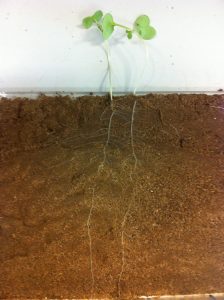 Phosphorus (P) is essential to all living things. Every single cell in plants, animals and microbes, down to our very own DNA requires P to survive and grow. Modern agriculture is dependent on P fertilizer, especially in high yielding systems where the biomass (and therefore the P) is continually exported to local, or sometimes international markets. Since the UK does not have an internal supply for P fertilizers, it is dependent on outside sources and makes it vulnerable to political instability and potential price fluctuations. The recent seizure of a New Zealand bound phosphate shipment highlights this issue. On the other hand, over application of P-containing compounds to soil may lead to serious environmental issues, such as algal blooms in down-stream waters. Nutrient transport is becoming an increasing concern as extreme weather events and flooding occur more frequently. Our food supply and the state of our environment is at risk and we must identify solutions now.
Phosphorus (P) is essential to all living things. Every single cell in plants, animals and microbes, down to our very own DNA requires P to survive and grow. Modern agriculture is dependent on P fertilizer, especially in high yielding systems where the biomass (and therefore the P) is continually exported to local, or sometimes international markets. Since the UK does not have an internal supply for P fertilizers, it is dependent on outside sources and makes it vulnerable to political instability and potential price fluctuations. The recent seizure of a New Zealand bound phosphate shipment highlights this issue. On the other hand, over application of P-containing compounds to soil may lead to serious environmental issues, such as algal blooms in down-stream waters. Nutrient transport is becoming an increasing concern as extreme weather events and flooding occur more frequently. Our food supply and the state of our environment is at risk and we must identify solutions now.
One possibility for reducing fertilizer requirements and decreasing the concentration of P in runoff is to improve the efficiency of P uptake by plants. Soils contain an abundance of P in various forms, although only a very small percentage of P may be present as orthophosphate (PO4–) that can be taken up by plants. To deal with low PO4– concentrations, plants and microbes have evolved with remarkable (but poorly understood) techniques to break down larger molecules into usable forms. For example, many bacteria contain a set of genes that “turn on” when they don’t have enough orthophosphate (PO4–) in their environment. This triggers the production of enzymes to break a bond in larger organic P molecules, thus freeing the PO4– for uptake.
Phosphorus cycling in the soil-microbe-plant continuum of agri-ecosystems aims to identify how plants and microbes can work together to improve P utilisation from the soil. We are growing oilseed rape plants in field soils (pictured) under controlled conditions to evaluate the effects of P fertilizer application and bacterial inoculants on soil enzymes, changes in P forms and plant growth. The focus is on the rhizosphere, the soil closest to the root, since this can be a hotspot for microbial activity and biochemical reactions. Advanced techniques in genomics, transcriptomics and proteomics are being applied, in combination with 31P nuclear magnetic resonance and enzymology to characterise the microbes, plants and soils. Ultimately, we need to understand the basic mechanisms to be able to create more sustainable production systems.
Dr Tandra Fraser, post-doctoral researcher , Soil Security Programme
This post is one of several posts about our work as part of the Soil Security Programme for Global Soil Week. Find out more about our work here.
